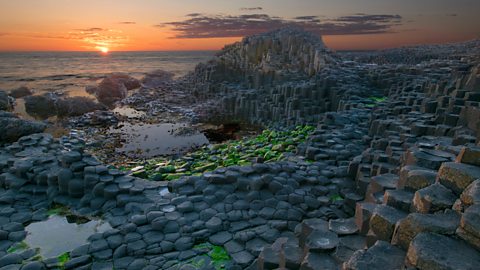Causes and global distribution of earthquakes
An earthquake is the shaking and vibration of the Earth's crustThe thin layer that is the outermost section of the earth. It varies from between 5 ÔÇô 70 km in depth and is broken up into several large pieces of rock which are known as plates. due to movement of the crust.
Earthquakes can happen anywhere there is a fault or weakness in the crust, however, major earthquakes usually only occur atplate boundariesThe region where two or more tectonic plates meet. It is a zone of intense seismic activity..
Plate activity gives rise to earthquakes which form a pattern of long thin linear "earthquake belts" around the world.
This belt is most noted in a circle around the Pacific Ocean, known as the Pacific Ring of Fire.
It is also seen in a line through the Atlantic Ocean, known as the Mid Atlantic Ridge.
Earthquakes occur when tension/energy is released from inside the crust.
Plates do not always move smoothly alongside each other and sometimes get stuck.
When this happens pressure builds up. When this pressure is eventually released as energy, an earthquake tends to occur.
Focus and epicentre
The point inside the crust where the pressure is released is called the focusThe place where the earthquake originally occurs deep inside the earth.
The point on the Earth's surface directly above the focus is called the epicentreThe place on the earthÔÇÖs surface which is the shortest distance directly above the focus. It is the place where the maximum intensity of the earthquake is felt..
Earthquake energy is released in seismic waves. These waves spread out from the focus.
The waves are felt most strongly at the epicentre, becoming less strong as they travel further away.
The most severe damage caused by an earthquake will happen close to the epicentre.
Measuring earthquakes
The power of an earthquake is measured using a seismometer.
A seismometer detects the vibrations caused by an earthquake. It plots these vibrations on a seismographThis is an instrument which is used to measure the intensity of seismic waves during an earthquake..
The strength, or magnitude, of an earthquake is measured using the Richter scaleThis is a scale which is used to measure the amount of power released during an earthquake event..
The Richter scale is open-ended from zero. The largest earthquakes even recorded have been close to magnitude 10.
Physical consequences of earthquakes
Liquefaction
Liquefaction is when an earthquake takes place and shakes the wet soil. The energy released by the earthquake causes the water within the soil (and rock) to rise up to the surface and can turn the soil into a liquid mud.
As a result of this, the foundations of buildings may be undermined causing them to collapse. Other underground services such as water and gas pipes may be broken causing leaks and fires. Often transport routes, including roads and railway lines are damaged.
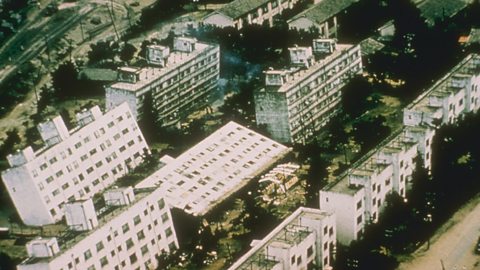
Tsunamis
A tsunami is a large wave that is created due to an underwater earthquake sending its shockwaves into the water which causes a surge of water to build up and make its way towards the coastline.
The energy transferred into a tsunami wave can often be transported for thousands of miles across an ocean.
Causes and impact of an earthquake
Earthquakes can destroy settlements and kill many people.
aftershocksSmaller earthquakes and tremors that follow the main quake. can cause even more damage to an area.
It is possible to classify the impacts of an earthquake by taking the following factors into account:
- short-term (immediate) impacts;
- long-term impacts;
- social and economic impacts (the impact on people);
- environmental impacts (the impact on the landscape).
| Social impacts (People) | Economic impacts (People) | Environmental impacts (People) | |
|---|---|---|---|
| Short-term impacts | Death and injury. Homes destroyed. Transport and communication links disrupted. Water pipes burst and water supplies contaminated. | Shops and business destroyed. Looting may take place. Damage to transport and communication links can make trade difficult. | The built landscape may be destroyed. Fires can spread due to gas pipe explosions. Fires can damage woodland areas. Landslides may occur. Tsunamis may cause flooding in coastal areas. |
| Long-term impacts | Disease may spread. People may have to be re-housed, sometimes in refugee camps. | The cost of rebuilding a settlement is high. Investment in the area may be focused only on repairing the damage caused by the earthquake. Income could be lost. | Important natural and human landmarks may be lost. |
Case study: Tohoku, Japan
On 11 March 2011, a massive 9.0 earthquake occurred off the Japanese coastline at 14:46.
The epicentre was 43 miles east of Tohoku at a depth of 20 miles.
The earthquake lasted 6 minutes and caused a tsunamiA tsunami is a large wave which is caused when an underwater earthquake sends shockwaves through the water, causing a surge of water to move towards the coastline. wave that reached heights of over 40 metres.
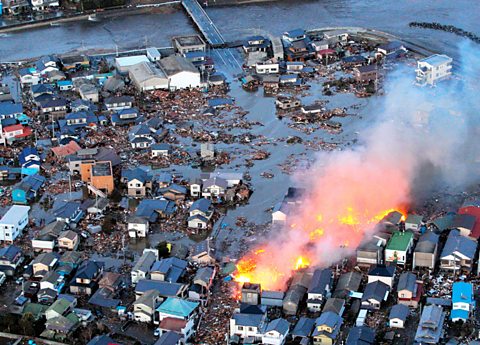
The plates involved
Japan is in one of the most active earthquake zones on earth.
The oceanic Pacific plate is moving towards the larger continental Eurasian plate at an average rate of 9cm a year.
They meet at a destructive plate marginThis happens where crustal plates move together and one is forced beneath the other. where a subduction zoneCaused at destructive plate margins where the oceanic plate is pushed underneath the continental plate. The movement of the plate downwards creates a subduction zone where huge amounts of friction mean that earthquakes take place. has formed off the east coast of Japan.
The denser oceanic Pacific plate is being subducted (forced) underneath the thicker continental Eurasian plate.
Friction has built up over time and when released in 2011 it caused a massive earthquake, reaching 9.0 on the Richter scale.
The amount of energy released in this single earthquake was equivalent to 600 million times the energy of the Hiroshima nuclear bomb.
Short-term impacts
| Impacts on people | Impacts on the environment |
|---|---|
| Deaths 16,000 died and a further 2,500 are recorded as missing. 92% of all deaths were due to drowning by the 40m high tsunami. | Tsunami waves up to 40 m high caused devastating damage and pollution up to 10km inland. Coastal ecosystems and habitats were damaged |
| Damage 330,00 buildings were destroyed or damaged, including 2000 roads and 300 hospitals. | Aftershocks Over 800 earthquakes of magnitude 4.5 or more continued to affect the region following the main earthquake |
| Blackouts Around 4.4 million households in North-East Japan were left without electricity. | |
| Unemployment Within one year 644 companies were forced into bankruptcy leaving thousands unemployed. |
Long-term impacts
| Impacts on people | Impacts on the environment |
|---|---|
| Economy- The economic cost was US$235 billion, making this the most expensive natural disaster in world history. | Liquefaction occurred in many of the parts of Tokyo built on reclaimed land. 1,046 buildings were damaged though few lives were lost. |
| Nuclear fallout ÔÇô The Fukushima Nuclear Power Plant meltdown released radiation. This raised the health risk, including cancers for local people. | Nuclear fallout ÔÇô High radiation levels from the nuclear power plant mean that 150km2 of Japan will be uninhabitable for over 40 years. |
| Homelessness ÔÇô Coastal towns and cities need to be rebuilt from scratch. This will take decades, eight years after the event 75 000 people were still living in temporary accommodation. | Planetary changes The earthÔÇÖs axis shifted by between 1-25cm, The earthÔÇÖs rotation speed increased, shortening the day by 1.8 microseconds. |
| Coastal land changes - A 400km stretch of JapanÔÇÖs coastline dropped by 0.6 m. |
Immediate and long-term strategies
Governments need to mobilise their rescue services quickly to respond to a disaster.
- Rescue services - In the short term, 100 000 soldiers of the national defence force and the rescue services moved into the affected area. They were able to clear roads and create access routes very quickly.
- Warnings ÔÇô Seismometers gave a one minute warning of the arrival of the strongest earthquake waves - bullet trains and lifts were automatically stopped. After 3 minutes a second warning for a tsunami was broadcast on 124 television stations giving residents 2-40 minutes to evacuate to higher ground.
- Healthcare - Many hospitals were destroyed or damaged and field hospitals had to be set up. Doctors and nurses were flown from other parts of the country to help with the relief efforts and many patients were flown far out of the emergency area to receive treatment.
- Shelter - Over 300,000 were left homeless and needed access to food, water, shelter and medicine. The army helped to build many temporary shelters very quickly.
- Rebuilding - The rebuilding of the worst affected areas began almost immediately. The government set up a Reconstruction Design Council who had a huge budget of over £120 billion to rebuild houses.
- Tsunami barriers - The original 12m tsunami barriers were replaced with ones that were 18m high. However, some scientists have noted that this would still not protect property if a similar earthquake was to take place.
- Normal lives - The Japanese people tried hard to get their lives back to normal in the weeks following the earthquake. Summer festivals continued as normal.
- Economic responses - Many Japanese manufacturers were affected by the earthquake (e.g. Toyota and Honda) because they could not restart production as factories and supply lines were damaged. It took around 1 › years for production to start to get back to normal.
- International Aid - The Japanese Red Cross received over $1 billion in donations and they gave out over 30,000 emergency relief kits and 14,000 sleeping kits.
Preparation for earthquakes in Japan
Some government strategies include:
- Predicting earthquakes: Over £70 million was spent on lasers that are used to monitor even the slightest movement.
- Practicing for earthquake emergencies: Every year on 1st September a nationwide earthquake and tsunami drill takes place to make sure that the population along with the rescue and emergency services, know how to respond.
- Earthquake-proofing the buildings: Billions of pounds have been spent making buildings more resistant to earthquake hazards, including liquefaction. This involves using types of glass that do not shatter, weights in the building to counter the sway or huge shock absorbers in the foundations. The 2011 event highlighted the success of these measures as almost all modern buildings survived the shaking without damage.
- Setting up early warning systems: Japan has had a tsunami warning system since 1952. There is also a complicated network of seismographThis is an instrument which is used to measure the intensity of seismic waves during an earthquake. across the country to monitor and report any earth movements.
Activity: Take the test
More on The restless earth
Find out more by working through a topic
- count4 of 4
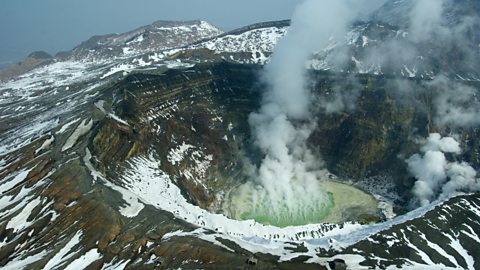
- count1 of 4
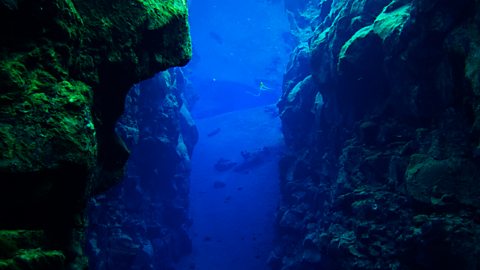
- count2 of 4
